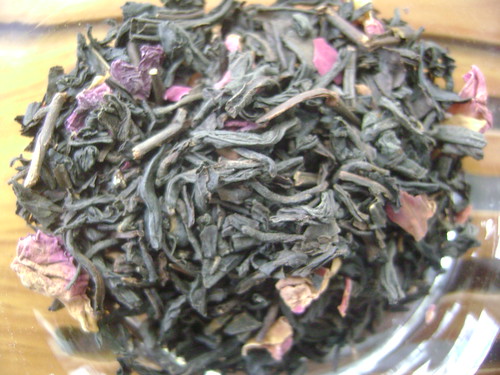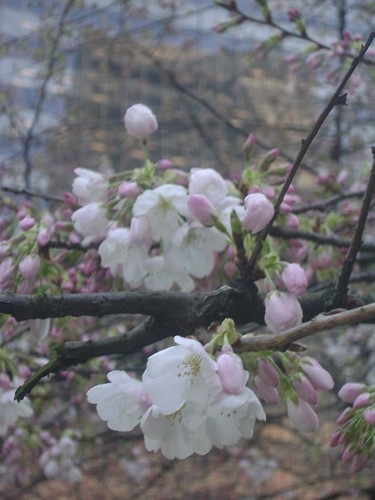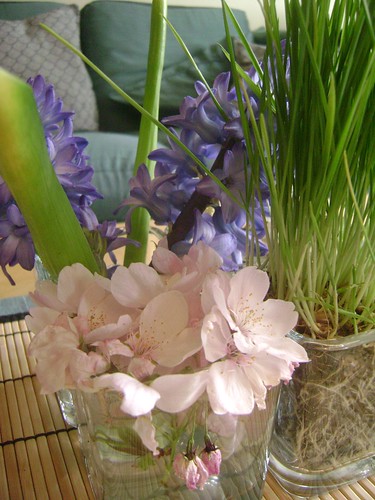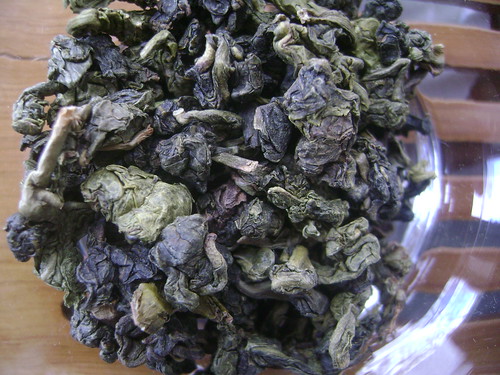In this very modern and laid-back tea ceremony, I have incorporated botanical symbolism from a few cultures to create a modern tea celebration to welcome spring. The botanical symbolism was also included in the flower arrangement. The centerpiece at the tea table was this 4 piece bouquet of cherry blossoms, hyacinths, sprouted wheat and white magnolia.
Hyacinths (sonbol - سنبل)and sprouted wheat (sabzeh - سب) are both part of the "Haft Sin" - the 7 S's in Persian botanical symbolism for new year, which occurs every year on the day of the Vernal Equinox. The hyacinths symbolize spring, and the sprouted wheat symbolizes rebirth. Some of the other symbols are a wheat-germ pudding, garlic, sumac, apples and vinegar and coins (read more here), all to invite different blessings into the new year.
Magnolias were chosen simply because they are in season. In the European language of flowers magnolia means nobility and love of nature. I think the love of nature in this celebration is quite self evident!
Sakura (Japanese for Cherry blossoms) are a symbolic flower in Japan. Cherry blossoms and tree blossoms in general mark the return of spring. It is the happiest time for Japanese people as they celebrate the beauty of the trees in full bloom (the peak of which lasts only but several days), and even appreciate the beauty of the petal's falling down like snow... Sakura's beauty is intense and short-lived, and it is spiritually symbolic of the samurai warrior's short life: the samurai will sacrifice his life at any time to serve and protect his master, and lives a short but fulfilled life. Sakura symbols are incorporated into numerous family crests and also in the Japanese, and is Japan's national flower.
Interestingly, in Israel, there is a celebration surrounding the blossoming of the almond trees (also from the same family as cherry and plum). It occurs a lot earlier - usually sometime in late January to mid February. It is called Tu BiShvat and is considered the "New Year of the Trees". It is the best time to plant trees, and this is what the whole holiday is about. Other traditions include eating dried and fresh tree fruit, and most commonly - fruit salad containing dried fruits, almonds and nuts. The Kabbalists also celebrate Tu BiShvat with a "Seder" - a seasonal ritual incorporating different blessings, prayers and symbolic foods. The Seder of Tu BiShvat, similarly to that of Passover, calls for drinking 4 glasses of wine. However, instead of them being all red (as in Passover), each glass of wine is a different colour, to symbolize the four seasons, the four elements, and the four worlds of Kabbalah (that would be too esoteric to get into now); as well as the changing of colours of the flowers in the region from fall through late spring: in the beginning of the year (which for the Jewish faith begins in the fall), wild flowers are all white (Chaztav in September). Therefore, the first glass of wine is all white. Next come lightly coloured flowers (i.e.: Cyclamen and Karmelit during the winter), so the second cup is white wine mixed with a few drops of red; The third cup is the other way - red with a little bit of white wine; and lastly, the fourth cup of wine is pure red wine, which reflects the colours of flowers at the peak of spring - red anemonies and poppies.
I have decided to adopt the four cups concept, but use tea instead. I thought it would be neat to celebrate spring with the different phases of tea and how it's processed, from the most pure form of tea to the more fermented and oxidized etc. And I've also used some flowers in the process to make it even more fun and spring-like!
The different degrees of oxidation of tea leaves also affect the theine levels (aka the caffeine that is found in tea). White tea has the least, green has more, oolong is somewhere in the middle and black tea, which undergoes the most oxidation, has the highest theine levels. The white, green and oolong teas also have higher levels of anti-oxidants than black teas.
White tea is prepared from the first buds of tea leaves in early spring, and is the least processed of all teas. The buds are hand-picked, than steamed, slowly dried and does not undergo a process of oxidation like green and black teas. The result is the most delicate tea, the finest quality of which is called Silver Needle (Bai Hao Yinzhen), which you can see in the above photo and looks like needles covered in fine white silvery plume. The next grade is White Peony (Bai Mu Dan), which has the top bud and also the next two young leaves, which also have some of the same plume. Both are grown in Fujian province in China. Both produce a very light liquor and have a fine, delicate taste that I can only describe as slightly peppery.
For our first cup of tea, I've used a blend of equal amounts of Silver Needle and White Peony, with a little bit of crystalized ginger and vanilla bean that I chopped up.
Sencha is the purest green tea, and like white tea (and unlike Chinese green teas), is not roasted. Steaming prevents it from oxidizing, than rolled, dried and finally - fired in order to preserve them and give their distinct flavour. The result is a very fine, fresh and aromatic tea with a very vegetal and at times even seaweet like aroma. Other sencha tea leaves have a more nutty aroma, or in the case of the one I've picked (organically grown), a little fruity too (similar to peach or osmanthus). I blended it with ume (plum) blossoms, which I picked and dried myself during spring break in Victoria's Esquimalt neighbourhood.
Oolong teas are like the champagne of teas. They are classified as somewhere in-between green and black tea (some are closer to green and some are closer to black). The best oolong teas grows in Taiwan or Fujian. The leaves are rolled into balls or longer curls. Many oolongs have a flowery aroma on their own. Some are further perfumed with flowers - such as this gorgeous magnolia scented oolong. Since the magnolias are out I thought it was a perfect occasion to brew this beautiful tea and share it with my guests. It is one of my favourite teas, and the more I get into teas, the more I discover how much I love oolongs in general. They are extremely different from one another and are just perfect on their own, with no sweeteners or any other flavours added. They are very rich in flavour, and are brewed rather concentrated, which gives off a bitter taste at first that turns very sweet aftertaste. They can also be re-steeped for many times (even as many as 7 with high quality oolongs!).
 Rose Congou, originally uploaded by Ayala Moriel.
Rose Congou, originally uploaded by Ayala Moriel.
Rose Congou (or Gongfu) is a perfumed black tea that is formed into thin strips from unbroken tea leaves. It is oxidized with rose petals, which give off their sweet, fruity-floral aroma, and some of the rose petals are left with the tea for decoration. It gives off a liquor that is a little lighter than some other black teas, but is very rich in flavour.












